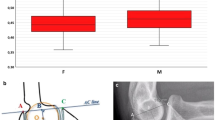Abstract
Background
Only a limited number of studies have investigated the age ranges in which the secondary centers of the elbow appear and ossify. Knowledge of sequence, gender differences and age ranges can aid in accurate assessment of radiographs, especially in cases of injury.
Objective
To determine the sequence and general age ranges in which each ossification center both appears and fuses, and also to identify differences between genders.
Materials and methods
This study included 412 sets of radiographs of children’s elbows that were analyzed prospectively by a single experienced pediatric radiologist. The presence as well as state of fusion of each ossification center was noted. The ages of the children ranged from 2 months to 17 years.
Results
In girls, the radial head and medial epicondyle appeared at the same age. In boys, there was a trend towards the radial head appearing earlier than the medial epicondyle. There was no statistically significant difference between the age at which the trochlea and olecranon appeared. Our results demonstrate a statistically significant difference between genders in both appearance and fusion. All centers both appeared and fused earlier in girls, with the exception of the appearance of the capitellum. The sequence of appearance and fusion was similar between genders.
Conclusion
Ossification centers at the elbow both appear and fuse earlier in females but the normal range in age for the times of appearance and fusion of these centers is quite wide for both sexes.

Similar content being viewed by others
References
Girdany BR, Golden R (1952) Centers of ossification of the skeleton. AJR 68:922–924
Garn SM, Rohmann CG, Silverman FN (1967) Radiographic standards for postnatal ossification and tooth calcification. Med Radiogr Photogr 43:45–66
McCarthy SM, Ogden JA (1982) Radiology of postnatal skeletal development: VI. Elbow joint, proximal radius, and ulna. Skeletal Radiol 9:17–26
McCarthy SM, Ogden JA (1982) Radiology of postnatal skeletal development: V. Distal humerus. Skeletal Radiol 9:239–249
Reed MH (1992) Pediatric skeletal radiology: appendicular skeleton. Williams & Wilkins, Baltimore, MD, pp 352–357 Section 3
Poznanski AK (1976) Radiologic evaluation of maturation. Practical approaches to pediatric radiology. Year Book, Chicago, IL, pp 293–309
Cheng JC, Wing-Man K, Shen WY et al (1998) A new look at the sequential development of elbow-ossification centers in children. J Pediatr Orthop 18:161–167
Census data, the City of Winnipeg. Available via http://winnipeg.ca/Census/2001/City%20of%20Winnipeg/City%20of%20Winnipeg/City%20of%20Winnipeg.pdf Accessed Sep 2007
Davies DA, Parsons FG (1927) The age order of the appearance and union of the normal epiphyses as seen by x-rays. J Anat 62:59–71
Galstaun G (1937) A study of ossification as observed in Indian subjects. Indian J Med Res 25:267–291
Patterson RS (1929) A radiological investigation of the epiphyses of the long bones. J Anat 64:29–46
Flecker H (1942) Time of appearance and fusion of ossification centers as observed by roentgenographic methods. AJR 47:97–120
Bajaj ID, Bhardwaj OP, Bhardwaj S (1967) Appearance and fusion of important ossification centers: a study in Delphi population. Indian J Med Res 55:1064–1067
Khanna KK, Kiran S (1979) Radiological study at wrist and elbow-epiphysial fusion with diaphysis. Indian J Med Sci 33:121–125
Sempe M (1976) Skeletal growth and maturation of the elbow. Kinetic study. Ann Radiol (Paris) 19:733–742
Eveleth PB, Tanner JM (1990) Worldwide variation in human growth, 2nd edn. Cambridge University Press, Cambridge, MA
Camp JD, Cilley EI (1931) Diagrammatic chart showing time of appearance of various centers of ossification and period of union. AJR 26:905
Flory CD (1935) Sex differences in skeletal development. Child Dev 6:205–212
Author information
Authors and Affiliations
Corresponding author
Appendix
Appendix
Ossification center appearance
Percentage of children with the lateral epicondyle present at various ages. In girls the lateral epicondyle appeared earlier than in boys. At any given age a greater percentage of girls demonstrated a lateral epicondyle (% P<0.05). The rate of change of the percentage of children at any given age was significantly different between genders (slope P<0.05)
Ossification center fusion
Rights and permissions
About this article
Cite this article
Patel, B., Reed, M. & Patel, S. Gender-specific pattern differences of the ossification centers in the pediatric elbow. Pediatr Radiol 39, 226–231 (2009). https://doi.org/10.1007/s00247-008-1078-4
Received:
Revised:
Accepted:
Published:
Issue Date:
DOI: https://doi.org/10.1007/s00247-008-1078-4
















